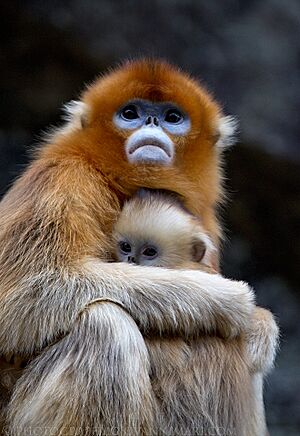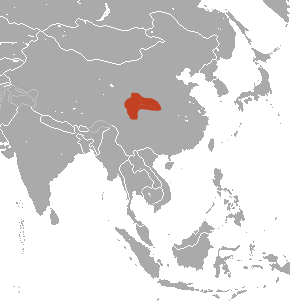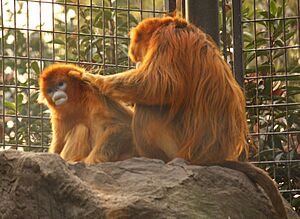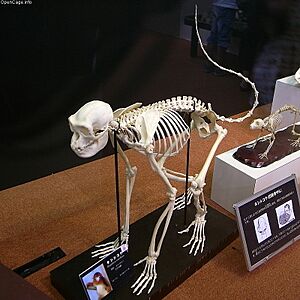Golden snub-nosed monkey facts for kids
Quick facts for kids Golden snub-nosed monkey |
|
|---|---|
 |
|
| Conservation status | |
| Scientific classification | |
| Genus: |
Rhinopithecus
|
| Species: |
roxellana
|
 |
|
| Golden snub-nosed monkey range | |
The golden snub-nosed monkey (Rhinopithecus roxellana) is a special type of monkey found only in central and Southwest China. These monkeys live high up in the mountains, in forests that are between 1,500 and 3,400 meters above sea level. In China, they are often called the Sichuan golden hair monkey or the Sichuan snub-nosed monkey.
Golden snub-nosed monkeys are known for being able to handle cold weather better than most other monkeys. Snow often falls where they live. Their diet changes with the seasons, but they mostly eat plants, especially lichens. They are active during the day and spend almost all their time (about 97%) in the trees. There are three different kinds, or subspecies, of this monkey. Scientists believe there are about 8,000 to 15,000 of them left. Sadly, their homes are shrinking, which puts them at risk.
Contents
Monkey Families: Subspecies
Scientists have found three different types of golden snub-nosed monkeys. You can mostly tell them apart by how long their tails are, and by some small differences in their bones and teeth. These different groups live in separate areas because there are many people living in between them.
- Moupin golden snub-nosed monkey (Rhinopithecus roxellana roxellana): Most of these monkeys live in the mountains of Sichuan province. Between 1995 and 2006, about 10,000 of them were counted. Smaller groups also live in parts of Gansu and Shaanxi provinces.
- Qinling golden snub-nosed monkey (Rhinopithecus roxellana qinlingensis): This group lives in the Qinling Mountains of southern Shaanxi. In 2001, there were about 3,800 to 4,000 of these monkeys. A wide valley separates their mountains from other monkey groups.
- Hubei golden snub-nosed monkey (Rhinopithecus roxellana hubeiensis): These monkeys are found in the Daba Mountains of western Hubei and northeastern Chongqing Municipality. In 1998, there were about 600 to 1,000 of them. By 2005, their numbers in the Shennongjia Nature Reserve had grown to over 1,200.
How Golden Snub-nosed Monkeys Look
Male and female golden snub-nosed monkeys look different, especially as they get older. This is called sexual dimorphism.
Adult Males (around 7+ years old)
Adult males are large. They have very long, golden hairs on their backs and shoulders, like a cape. Their heads are dark brown, and their arms and outer thighs are also deep brown. The hair on their head stands up, which helps scientists tell them apart. They are usually between 58 and 68 centimeters tall and weigh about 16.4 kilograms.
Subadult Males (5–7 years old)
These males are similar in size to adult males but are thinner. Their golden cape hairs are shorter and not as thick. Their brown head hair might show small stripes.
Adult Females (around 5+ years old)
Adult females are smaller than males, about half their size. Their backs, heads, shoulders, arms, and outer thighs are brown to deep brown. They also have golden hairs, but they are shorter than the males'. Their heads might show small stripes. After having babies, their breasts and nipples become larger and are easy to see. They are usually between 47 and 52 centimeters tall and weigh about 9.4 kilograms.
Subadult Females (3–4 years old)
These females are smaller than adult females, about two-thirds their size. Their body hair is light brown and slowly turns golden, but they don't have the long golden cape hairs yet. Their heads also show small stripes. Their breasts and nipples are not as large as adult females'.
Juveniles (1–3 years old)
Young monkeys are quite small, less than two-thirds the size of adult females. Their body hair is light brown and slowly turns reddish-gold. The rest of their body hair is brown. They don't have the golden hairs on their backs or the special head hair seen in older monkeys.
Infants (3 months to 1 year old)
Infants are light brownish-gray or light brown, and they look white in sunlight. They often play with older young monkeys but spend most of their time with their mothers, feeding or clinging to them for safety. It's hard to tell if they are male or female at this age.
Newborns (less than 3 months old)
Newborn babies are dark to light gray. After about two months, they turn light brownish-gray. They rarely leave their mothers or other females who might be carrying them (this is called alloparenting, where others help care for the young). Their sex cannot be told apart at this age.
Where Golden Snub-nosed Monkeys Live
Golden snub-nosed monkeys live in cool mountain forests in four provinces in China: Sichuan, Gansu, Shaanxi, and Hubei. They are found at heights from 1,500 to 3,400 meters. The types of trees change with how high up they are. Lower down, there are forests where trees lose their leaves. Higher up, there are mixed forests with both leafy and pine trees. Even higher, there are only pine trees. The average temperature is about 6.4 degrees Celsius, but it can get as cold as -8.3 degrees Celsius in January.
The area a monkey group uses for living and finding food changes with the seasons. This is because their food sources change throughout the year. Sometimes, a group's home range can be very large, up to 40 square kilometers!
Monkey Life: Behavior and Social Groups
Golden snub-nosed monkeys live in groups that can be as small as 5-10 monkeys or as large as 600! Their social life is quite complicated. The basic family unit is called a "one-male-unit" (OMU). This unit has one adult male, several adult females, and their babies. Many OMUs can join together to form a much bigger group. Sometimes, these large groups are made up of many males and many females.
The main male in an OMU might sometimes stay by himself, away from the rest of his group while they rest. Adult females often spend more time together than with males or young monkeys. While groups stay close, different OMUs often have small disagreements if they get too close. However, when there's danger, both males and females will help each other and protect their young by putting them in the middle of the group.
Protecting the young is a team effort. Mothers often get help from other monkeys to care for their babies. If a dangerous animal like a northern goshawk (a type of hawk) is near, the young monkeys are quickly moved to the center of the group. The strong adult males then go to face the danger. For the rest of the day, the group stays closer together, keeping the young safe in the middle.
Golden snub-nosed monkeys often sleep in groups to stay warm, especially when it's freezing. They usually sleep in the lower parts of tree branches, away from the cold, windy tops. They form bigger sleeping groups at night than during the day. The most common sleeping groups are mothers with their young, or adult females with other adult females. Adult males often sleep alone or stay on the lookout for danger. Sleeping in groups helps them save heat and also protects them from predators.
What Golden Snub-nosed Monkeys Eat
Golden snub-nosed monkeys eat many different things, but their favorite food is lichens. They also eat young leaves, fruits, seeds, buds, older leaves, herbs, tree bark, and flowers. What they eat changes with the seasons. For example, from November to April, they mostly eat lichens. From May to July, they eat a mix of leaves and lichens. From August to October, they eat a mix of fruits (or seeds) and lichens. When there's more fruit available in the summer, they eat fewer lichens. They like lichens that grow on certain trees like Cerasus discadenia, Salix wallichiana, and Malus halliana. Lichens grow a lot on dead trees.
These monkeys prefer to find food in larger trees in old and young forests. They rarely go into shrub forests or grasslands. Even though they mostly stay in trees, they have several predators. These include mammals like dholes (wild dogs), wolfs, Asiatic golden cats, and leopards. Birds like the golden eagle and northern goshawk also hunt them.
Monkey Social Life
The basic social group is the one-male, multi-female unit (OMU). This unit has one male who mates with several females, and their babies. There are also "all-male units" (AMUs), where several single males live together. Many of these are young males who have left their family OMU. Sometimes, adult males who used to lead an OMU also join AMUs. Males in AMUs have a pecking order, and they are often related. Males who live alone are usually adults who have been replaced as the main male in an OMU. They might join an all-male group or follow a breeding group, hoping to take over an OMU.
A "breeding band" is a group of OMUs that do their daily activities together, like feeding, resting, and traveling. Even though they are together, monkeys from different OMUs in the same breeding band usually don't interact much. An "all-male band" is made of 1-3 AMUs that are separate but do things together. A "herd" is a breeding band, an all-male band, and any single males together. A "troop" is two or more herds in a large area. Monkeys and OMUs can move between herds in this complex society.
Protecting Golden Snub-nosed Monkeys
The golden snub-nosed monkey is an endangered animal. This means there aren't many left, and they are at risk of disappearing forever. Their biggest problem is that their homes are being destroyed. For example, lichens are a very important food for them, and lichens grow best on dead trees. But sadly, dead trees are often cut down, which means less food and a poorer home for the monkeys. These monkeys are very picky eaters, so damage to their habitat really hurts them.
Luckily, these monkeys live in several protected areas, like the Baihe Nature Reserve and Foping National Nature Reserve. The golden snub-nosed monkey is also listed on Appendix I of CITES, which means it's against the law to trade them internationally. In 2004, the country of Guernsey even put this monkey on a postage stamp to help raise awareness about its endangered status.
Golden Snub-nosed Monkeys in Zoos
Outside of mainland China, only zoos in Hong Kong, Japan, and South Korea currently have golden snub-nosed monkeys. The San Francisco Zoo had them in 1985, and the San Diego Zoo had them from 1984 to 1989.
See also
- List of endangered and protected species of China
- Snub-nosed monkey
- Wildlife of China




